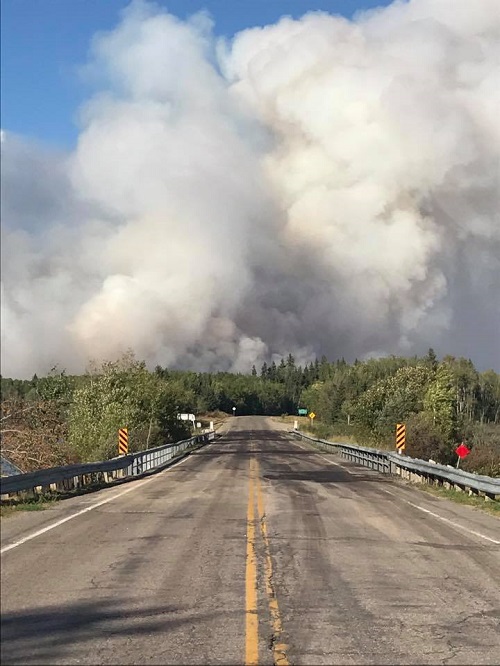Granite Fire viewed from Hanson Lake Rd. Hwy #106 near Flin Flon on Aug. 26. Photo courtesy Vanessa Linklater-McCallum.
*UPDATE (4:40 p.m., Monday, August 28th) — Due to the Granite wildfire crossing the highway northwest of Creighton and east of Pelican Narrows, Highway 106 is now closed from the junction of Highways 106 and 135 (the Pelican Narrows junction) eastbound to Creighton/Flin Flon.
Residents of Creighton and area will be able to travel westbound to Tyrell Lake before being turned back due to the highway closure.
Residents of Pelican Narrows can only travel southwest to Prince Albert on Highway 106, but will not be able to head northeast to Creighton due to the Granite fire surrounding and crossing highway 106 (also known as the Hanson Lake Road).
This message is from Saskatchewan Highways.
Please stay clear of this area and stay safe.
Keep listening to MBC for further wildfire and road restrictions in the northeast region.
The 17 residents of Birch Portage south of Pelican Narrows remain displaced from their homes because of a 350 square-kilometre forest fire, but crews have prevented the fire from burning any structures.
As well, the smoke situation has eased up a bit near Pelican Narrows, about 70 kilometers to the north.
Two of the three fires burning in the area are uncontained at this time.
The chief of the Peter Ballantyne Cree Nation, Peter Beatty, says there was a bit of a break over the weekend.
“We have a south-west wind that is clearing the air for Pelican,” he said. “Yesterday there were no smoke issues regarding that community.”
He adds no one had to be treated in hospital. As well, the chief says the local school has an air scrubber so if the situation does get bad again there is a place for people to go.
The executive director of the wildfire management branch, Steve Roberts, says the situation remains unpredictable because of the high temperatures, low humidity and changing winds.
He says one of the fires remains about 16 kilometers south of Pelican Narrows, while another is burning north of the community. He says all the province’s fire-fighting efforts are focused around Pelican Narrows.
“Yeah, if we were distracted and we had multiple areas then it limits our abilities for instance to get things like air tankers,” he said.
“So this group has a good supply of air tankers, both retardant and water, and we have moved crews from around the province to that area.”
There has been no significant rain in the area since July. Roberts says everything is bone dry, making for volatile fire conditions. Cooler temperatures and higher humidity at night are helping reduce the fire risk as we move towards fall weather.
